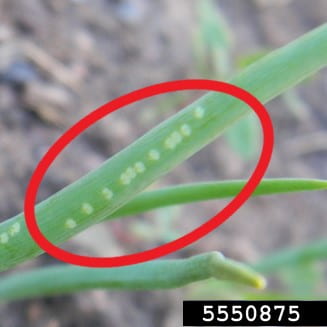September Insect & Disease Scouting Tips
By Emily Zobel, AgFS Agent, Dorchester County, UME
ezobel@umd.edu
Cole Crops/ Brassicas: Continue to scout all fields for caterpillar pests (armyworm, diamondback moth larvae (DBM), and cabbage looper larvae). For fresh-market crops, treat when 20% of the plants are infested during the seedling stage, then 30% infestation till the cupping stage. Use a 5% threshold from early head to harvest for cabbage and Brussels sprouts. For broccoli and cauliflower, use 15% at curd initiation/cupping, then 5% from curd development to harvest.
Good identification as early as possible is important because some products may not be labeled or as effective for all brassicas caterpillar pests. If treatment is needed, adjust your spray pattern so that the spray is getting sideways to the undersides of leaves, particularly when using Bt and other contact materials. Due to resistance development, pyrethroid insecticides (Group 3A) are not recommended for controling DBM. Effective materials should eliminate DBM larvae within 48 hours. Make sure to re-scout treated fields within 3 days to assess the efficacy of the insecticide applications.
Check young plants for flea beetles. Thresholds for flea beetles are 1 per transplant or 5 beetles per 10 plants. They will lay eggs in the soil, and larvae can cause significant root injury. Downy mildew and Alternaria can be problematic in fall brassica crops (cabbage, collards, broccoli, cauliflower, and kale). When the disease first appears, apply a fungicide every 7 to 10 days.
Alium crops: Scout fall leeks, garlic, or other Allium species from now until the first freeze for Allium leaf miner damage. Egg-laying damage consists of several small round white dots (made by the female’s ovipositor) that appear on the leaf blades (fig 1). Larvae will live inside the leaves before moving down to the bulbs, where they feed and eventually pupate and overwinter. The feeding damage can open up the foliage and bulb to fungal infections. Row covers can be used to exclude this pest when Alliums are first planted. For organic production, spinosad (Entrust is OMRI-labelled) works well in controlling the larvae. Two or three applications of the insecticide used 2 weeks apart from each other, with the first one coming only after oviposition marks are seen, should offer good control of this pest. The use of a penetrant adjuvant such as neem oil is recommended for better control.

Lima Bean: Check any latelima bean for soybean looper and stink bugs. Looper activity should decline once nighttime temperatures drop into the low 50s.
Swiss chard, Beets & Spinach: Check for beet webworm. They fold leaves and cause window-paning feeding damage. They also feed on pigweed.
Sweet Corn: Corn earworm (CEW) numbers have been declining across the state. Cooler night temperatures and shorter day lengths have triggered mature larvae to enter diapause as overwintering pupae.
Spider mites: Now is a great time to treat weeds growing in and around greenhouses. Winter annual weeds such as chickweed, henbit, dead nettle, and speedwell serve as spider mites and thrip habitats, allowing them to overwinter. Treating now will reduce the possibility of having early-season pest activity on transplants next year.